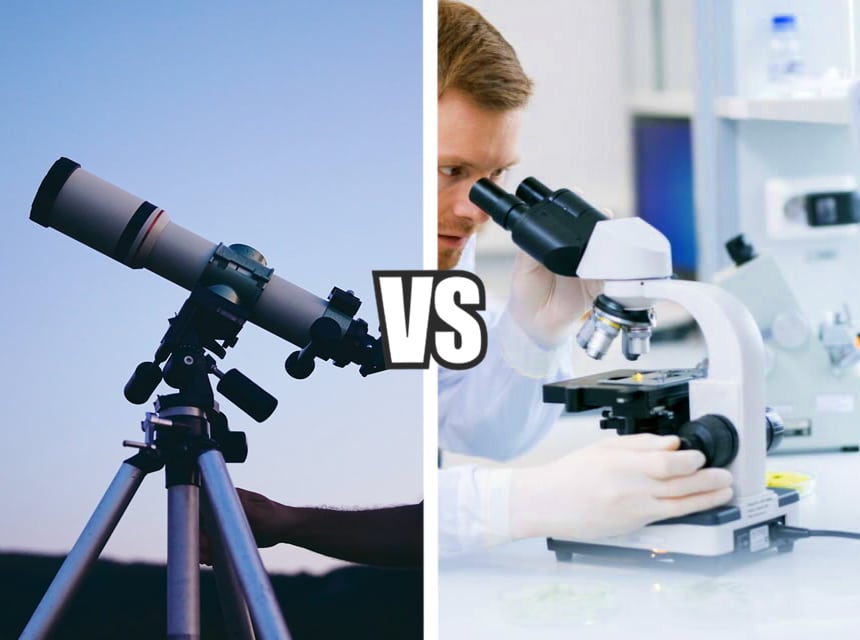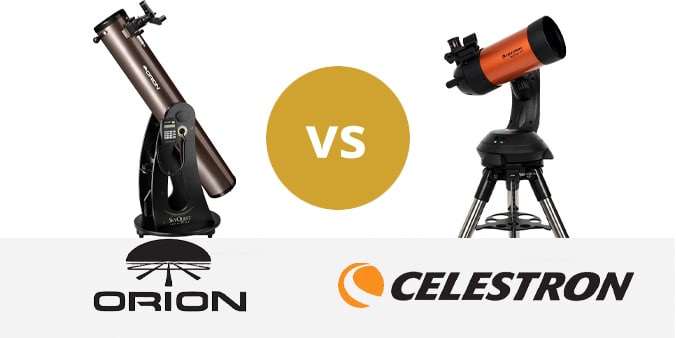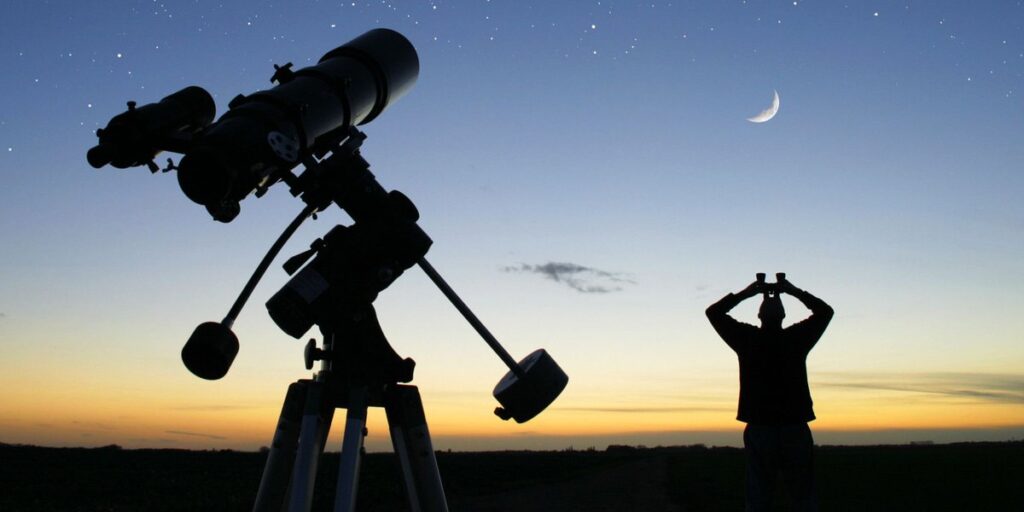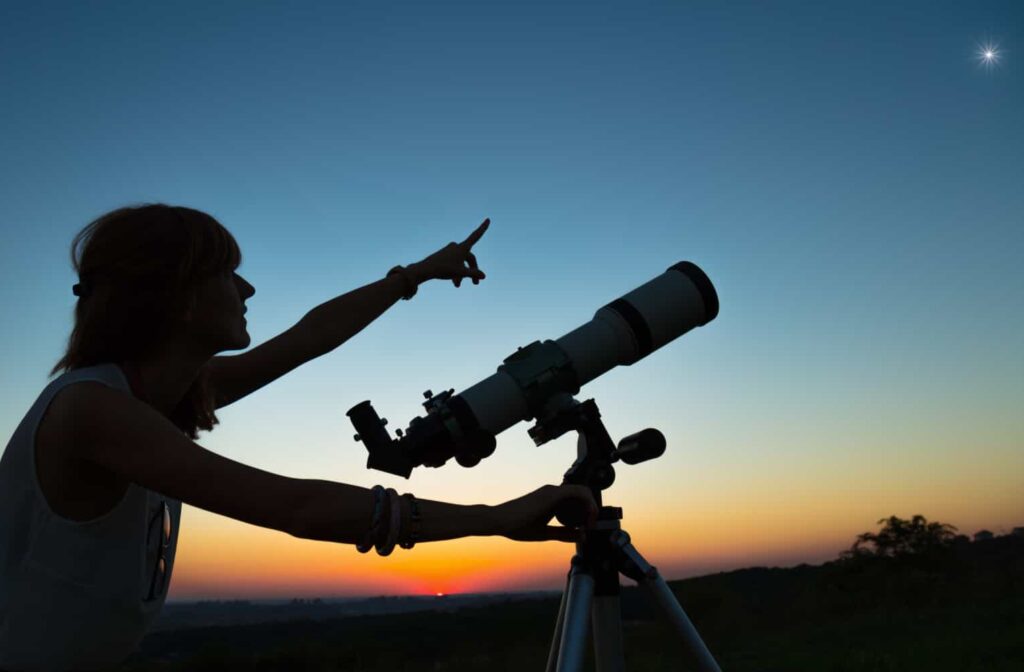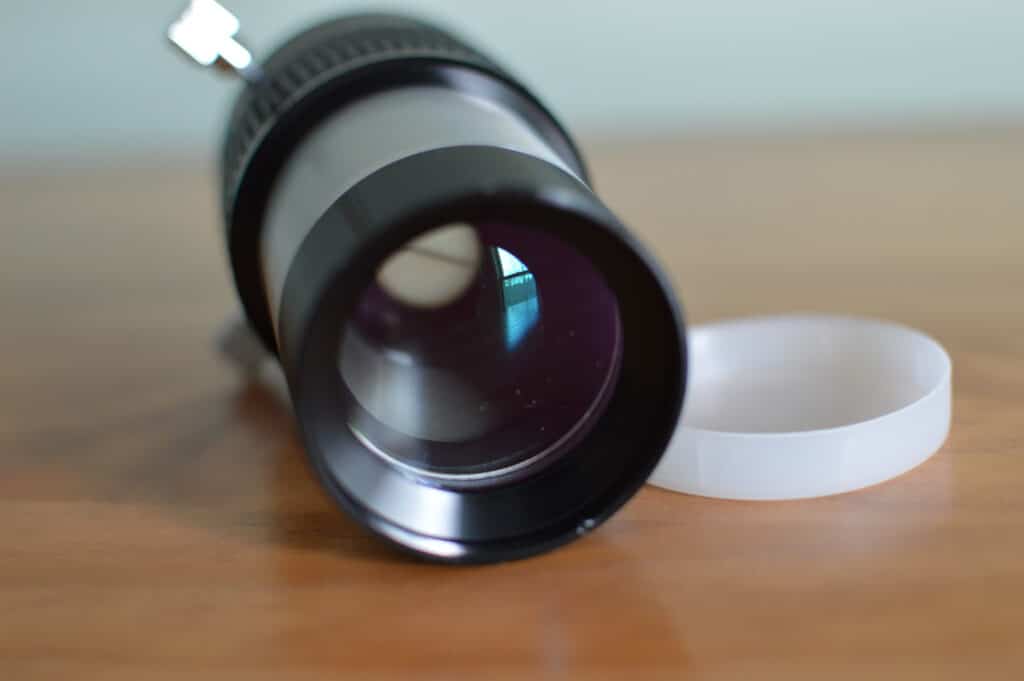

If you’re interested in taking up astronomy, but don’t have the ideal viewing conditions at your home, you’ll need a portable telescope. Unfortunately, not all top-rated portable telescopes are as good as described. While it may seem like there is not much to a telescope, don’t be fooled. There are actually some important features and issues you need to consider.
In our quest to find the best portable telescope, we considered the weight and dimensions, which impacts the overall portability. We also assessed the types of scopes, mounts and tripods. We also looked at the focal length and ratios, eyepiece diameters and apertures. Finally, we evaluated accessories such as carry cases.
Other features: 16” optical tube length, StarBright XLT optical coating, StarPointer finderscope, rigid adjustable tripod
The Celestron NexStar 6SE is part of the Celestron line that has a well-deserved reputation for myriad features and user-friendly assembly. The 150 mm aperture is a step up from many standard portable telescopes. There are also over 40,000 astronomical objects in the database for the NexStar+ hand controller. This means that you should always have new targets to look for. However, you will need extra eyepieces to capture them all.
This telescope also features a tour mode. This allows the telescope to carefully guide you to chosen targets. This is a great feature if you want to explore the night sky.
The NexStar 6SE also incorporates SkyAlign technology. This is easy to use and will get you quickly pointed in the right direction. The motorized mount has nine speeds and solar, lunar and sidereal tracking rates. However, this impressive technology does come at a cost. This telescope quickly drains batteries. So, if you can, set it up using an external power source.
While the NexStar 6SE has a slow f/10 focal ratio. But, there is the potential for a more advanced user to switch out the secondary mirror. This will create a smaller light path to increase the focal ratio to f/2.
Other features: 51 – 156 x magnification, StarPointer finderscope, StarBright XLT optical coating, integrated WiFi, all-metal tripod, integrated carry handles
Another Celestron NexStar offering in our list of the best portable telescope options is the Evolution 8. This has a massive 203.2 mm aperture and a 2032 mm focal length. This creates masses of light and is capable of reaching up to 480x highest user magnification.
In the box, there are two eyepieces. There is a 40 mm offering 51x magnification for wide field viewing and a 13 mm with 156x magnification for closer viewing. These provide a solid foundation as the best portable beginner telescope. However, you can supplement this with additional eyepieces such as a 4.2 mm which would provide 451x magnification.
The NexStar Evolution 8 has a single fork alt-azimuth mount, sitting on a medium weight tripod. This is a fully computerised mount that can be controlled with a smart divide connecting to the built in Wi-Fi or using the handbox controller. The Celestron SkyPortal app is available for both Android or Apple devices.
Additionally, the mount has a built in lithium ion rechargeable battery. This can be recharged using the supplied power adapter. It can provide power for your telescope all night.
There is also a StarPointer red dot style finderscope to help you navigate the night sky.
Other features: 1.5x Barlow lens, 5 x 24 finderscope, tabletop tripod, carrying case
The Barska 40070 may be a more budget pick, but it is still packed with features. It is both easy to set up and equipped with the basics needed to get started. The kit includes two interchangeable eyepieces, a finderscope, a table top tripod, carry case, and a beginner version of the Deepsky Barska astronomy software.
This software is a searchable database with more than 10,000 objects including star clusters, nebulae, variable stars, double stars and more.
The scope has coated glass optics to provide enhanced image brightness. It has also been carefully engineered with the smooth functioning mount to provide great functionality.
This model is a great way to start an interest in astronomy. You can start with the included 45º erect image diagonal and 1.5x Barlow lens and build your kit from there. Additionally, with a weight of just 4.4 pounds, the Barska 40070 is easy to transport to the best viewing spots with the minimum amount of light pollution. Furthermore, the tabletop mount will allow you to quickly set up in any spot.
Other features: full size steel tripod with EQ tilt plate, 30,000+ objects database, flip mirror system
The Meade ETX125 is the latest in the line of Meade’s Everybody’s Telescope products. It is the largest of the ETX models. However, it also has some nice upgrades. This scope is a very good performer. While they are primarily designed for moon and planet viewing, they do have sufficient aperture for some deep sky work.
The ETX125 does have a functional flip mirror, but you will need an adapter on the back to mount your camera. However, what you mount may hit the base of the mount fork, which could impact if you can reach the zenith or pole. It is also a good idea to go into the scope settings and set an altitude limit, so you don’t crash your camera accidentally when slewing.
Unlike the smaller ETX scopes, the optical tube of the ETX 125 cannot be easily removed from the fork mount. However, you’re not likely to want to do this regularly anyway. Another difference between this model and the previous ETX incarnations, there is a plastic clip on dust cap rather than a metal threaded one. Although you may think that metal would be better, trying to thread the cap off and on can be tricky and time consuming when you’re out and about.
Other features: adjustable tripod, wireless remote
For beginners looking to get into astronomy for the first time, the ToyerBee Telescope for Adults & Kids is an excellent option and doesn’t require any substantial financial commitments. It’s designed with a 70mm large aperture objective lens, with the provided field of vision being more than enough for planets and the moon. Magnification ranges from 15X to 150X, depending on how far your target object is.
The device is equipped with two eyepieces that you can switch between. One is a 20 mm option allowing for 15X magnification, while its 6 mm counterpart offers 50X magnification. Add the 3X Barlow lens, and you get 150X magnification with the 6mm eyepiece.
The telescope is also smartphone compatible, and you can attach your android or iOS device to get some snapshots of the night sky. Additionally, the incorporated smartphone adapter features a wireless camera remote, so you won’t have to take the pictures manually.
Another part of the package is an adjustable tripod. This component is 360° rotatable, so you can get a full view of the night sky. Also, like other tripods, you can raise and lower the telescope’s height to match the viewer’s height. That said, the highest it can go is 46” while the lowest is 16”. Therefore, taller individuals may have to bend to get a cleaner look into the eyepiece.
Other features: 5 x 24 finderscope, 3x – 1.25” Barlow lens, aluminum coating, 20” optical tube length, aluminum tripod
Another Celestron model that is worthy of inclusion on this list is the PowerSeeker 127EQ. This is another easy to set up scope. You don’t need any tools at all. All you need to do is attach the tube to the ready assembled tripod and mount. So you can be stargazing within minutes.
The PowerSeeker 127EQ is a Newtonian scope with a longer focal length from a far shorter tube. This makes it easy to carry both your tripod and scope with plenty of room for other equipment such as cameras or even some midnight snacks.
All you need to start is included in the kit. This includes two eyepieces, a 3x Barlow lens and a copy of Starry Night. This software has a database with over 10,000 celestial objects. The kit also includes an aluminum, lightweight tripod with an equatorial mount.
The scope itself has a 127 mm aperture. This will allow you to view close up details of the moon, nebulae, brighter planets and star clusters. This is supported with fully coated good quality optics for additional clarity.
The only potential drawback is that you’ll not get everything at this price point. The PowerSeeker 127EQ uses a spherical rather than a parabolic mirror. This could make optical aberrations more frequent. Additionally, you’ll need to religion or collimate the mirrors. This does take confidence and practice. Celestron supplies limited information on how to accomplish this, so it can be daunting for beginners.
Other features: 2x 1.25” Barlow lens, StarPointer™ red dot finderscope, StarSense smartphone dock, steel tripod
The Celestron StarSense explore does not require a computerized and motorized expensive mount. Instead there is an innovative smartphone holder on the basic alt-azimuth mount. This is not only the easiest mount to use, but it keeps the costs reasonable.
The LT114 has a Newtonian reflector that uses mirrors rather than lenses to gather light. This offers you greater bang for your buck in aperture size. It means that the 114 mm StarSense Explorer has twice the light gathering capacity of the 80AZ, but it costs the same and only weighs a pound more.
The smartphone dock mounts on the side of the telescope tube. The kit also includes a 2x Barlow lens.
Other features: slow motion controls, 2x Barlow lens, pre-assembled full-height stainless-steel tripod
The Meade Infinity 102 is an AZ refractor telescope. It features the largest aperture in the Meade Infinity line. While it may not be the most budget friendly of options, it is worth spending the extra cash.
The kit includes multiple eyepieces and accessories that are decent quality and offer excellent value. This makes the Infinity 102 a complete package for beginners.
The 102 mm (4 inch) aperture lens teamed with the 600 mm focal length produces a focal ratio of f/5.9. Despite the fact that this is considered an entry level model, it does offer great optical performance. This scope excels at wide field views.
There is a plastic dew shield on the front of the optical tube to block stray light and prevent objective condensation. Since this is an achromatic refractor, there may be some color fringing on the edges when looking at brighter objects. However, you may be able to use this scope for daytime terrestrial viewing.
The Infinity 102 is equipped with a fully assembled alt-azimuth tripod. This is made with cast aluminum and is height adjustable between 33 and 51 inches. The stainless steel tube legs feel sturdy, but it may be prone to some vibrations. So, be prepared to wait for the image to stabilize in a couple of seconds. To improve stability, try not fully extending the legs when possible.
Other features: AudioStar™, Red Dot viewfinder, full size steel tripod with EQ tilt plate
Another Meade ETX option on this list of the best portable telescope models is the ETX-90. This is another GoTo telescope that is great for beginners and more experienced astronomers. The telescope is quick and easy to calibrate and build. This is a great feature for beginners, but also those who don’t want to waste precious time assembling when you get to a good viewing spot.
The optics provide crisp, clean views due to its ultra-high transmission coating. You can pick up bright views of Saturn’s rings or the moon with stunning contrast and detail. However, the 3.5-inch objective lens allows you to pick out ice giant planets and other astronomical features.
The ETX 90 sits on a dual arm fork mount. This can be used in conjunction with the GoTo Audio Star handheld computer controller. This impressive tool contains a database with over 30,000 astronomical objects. This will help you to get up and running in next to no time. However, you will need to add to your astronomy kit with additional lenses to see the majority of the targets in the database.
The only minor criticism is that the hand controller can be tricky to read when you’re in low light. So, you’ll need to make sure that you carry a red flashlight in your kit bag so you protect your dark-adapted vision. It is also a good idea to purchase a power tank so you can consistently keep your scope running rather than relying on batteries.
With so many great portable telescopes on the market, it can be tricky to find the best one to suit your needs. So, here we’ve compiled a buying guide with features to consider and answers to some frequently asked questions to help you make your purchase decision.
There are three basic types of telescopes.
Refractor: These are the most common forms of portable scope. They are considered the standard type by many people. Refractor telescopes gather ambient light, focusing it on the eyepiece. This can offer high quality images. However, refractor telescopes are more susceptible to chromatic aberrations.
Newtonian: These telescopes take their name from Sir Isaac Newton. Sir Newton invented this form of scope. Newtonian scopes are typically the most affordable since they use parabolic mirrors. They are highly portable with no chromatic aberration issues. However, you will need to calibrate the telescope before you use it. This can be daunting for beginners, particularly as manufacturers don’t typically provide full instructions. For example, Celestron does not provide particularly helpful instructions for the PowerSeeker 127EQ.
Schmidt-Cassegrain: Commonly referred to as SCTs, these scopes are typically the most compact. They use mirrors at both ends to fold the optical path. This creates a portable, compact design. SCTs tend to be mid-price range, but the image quality can sometimes be lacking compared to other types of telescopes.
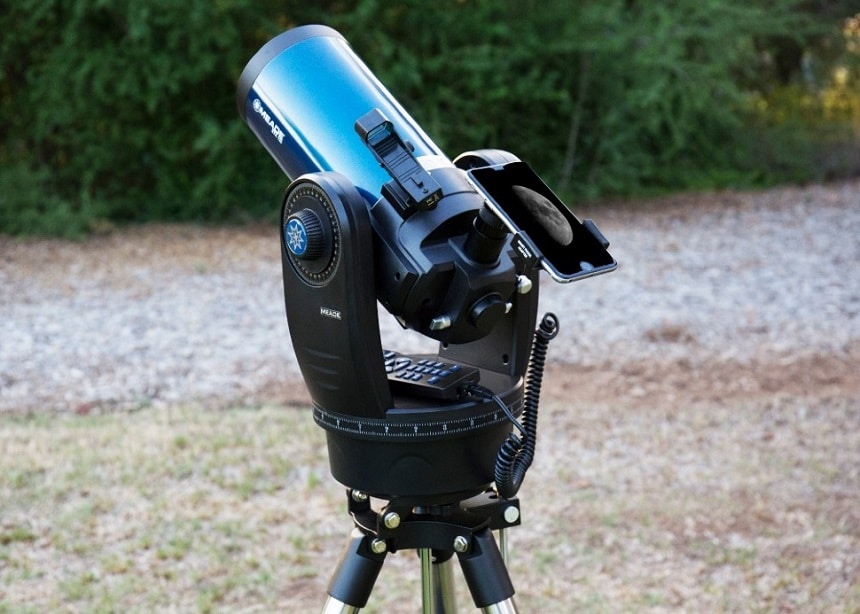
With the sheer variety of telescopes, you need to be aware of exactly what you’re looking for before you start shopping. So, here we’ll explore the features you should consider when choosing the best portable telescope.
Since you’re looking for a portable telescope, you’re likely to want a scope that is convenient to pack up and take to a good viewing spot. So, it is important that your new scope has the right weight and dimensions. However, this is a balancing act. You don’t want a scope and mount that is so lightweight it wobbles and is unstable. But, if your scope is too heavy and substantial, you may struggle to hike to a good viewing spot after you leave your car.
In addition to the weight of your scope, there are other portability features to look for. Folding tripods, travel cases and other accessories can make it easier to take your telescope to the best viewing spots. It is also worth considering the assembly and set up. If a scope is a little fiddly to assemble, you’re likely to struggle to do it in low light conditions.
The aperture refers to the diameter of the optical part of your telescope. It impacts the level of the light captured by your scope. This means that the aperture has a direct affect on the clarity.
However, when you want to take your scope with you, you will need to consider the aperture size. While a larger aperture will mean better images, it will increase the weight and size of your scope. You’ll need to balance scope size and aperture. Generally, six inches, such as you would find on the Celestron NexStar 6SE will provide a good balance of compact design and solid clarity.
Focal ratio or f/ratio is important for the optics of your telescope. Essentially, it describes the speed of the lens in any optical device. To calculate the f/ratio of a telescope, you need to divide the focal length with the aperture diameter.
The smaller the f/ratio, the wider the aperture, producing clearer, brighter images.
Focal length refers to the distance between the center of the lens and the focal plane where the image forms. The focal length depicts the magnification power of the scope.
Magnification is a vital aspect of a scope, but the magnification capabilities are often based on the eyepiece. So, it is possible to change the eyepiece and change the magnification.
You can calculate the maximum useful magnification by multiplying the aperture in millimeters by two. It is also 50 times the aperture in inches.
As we just touched on, eyepieces are important for your scope’s magnification. Each telescope produces a small image in the barrel. The eyepiece acts like a magnifying glass to get greater detail in the image. This means you can compensate for lower magnification with a sorter focus eyepiece.
Many telescopes are supplied with at least one or two eyepieces. But, it is possible to add more eyepieces to your kit to extend your scope’s range.
Barlow lenses take their name from its inventor, Peter Barlow. Barlow was an astronomer, optician and mathematician. He was also a member of the Royal Society of London. In simple terms, a Barlow lens can provide a cost-effective way to increase the eyepiece magnification.
These lenses feature a concave lens that lies between the objective lens of your scope and the eyepiece. This increases the eyepiece magnification by two or three times.
Your choice of mount is crucial for the overall astronomy experience. There are two main types of mount, equatorial and alt-azimuth (alt-az). Alt-az mounts are considered the standard. They allow moving the scope up and down, left and right. However, it will not track automatically. This type of mount tends to be more affordable and compact.
Equatorial mounts follow the sky’s rotation. This is typically a more expensive option, but it makes it easier to follow a map to navigate the stars.
GoTo refers to the type of telescope mount. In simple terms, this scope has a mount and software that work together to automatically point at selected astronomical objects. A computer and motor drive both axes of the GoTo mount. This can make it easier for beginners to become familiar with navigating the sky.
Finder scopes are small spherical optical devices that are above or sideways of the original telescope. A finder scope offers a large field of view that helps to access the manual settings of the telescope. They have a separate eyepiece and may even be connected to a digital screen.
As you can see there are some fantastic portable telescope options on the market. From the budget friendly, Barska 40070, which offers a great starter kit for beginners to the more premium Celestron NexStar Evolution 8. This may carry a premium price tag, but it is packed with features and has a massive 203 mm aperture.
However, the stand out as the best portable telescope has to be our editor’s pick, the Celestron NexStar 6SE. This impressive scope provides access to over 40,000 objects with the NexStar+ hand controller software. It also features SkyAlign technology that is easy to use and helps you to quickly point where you want to look. While the telescope may quickly drain batteries, you can use an external power source to be able to use the scope all night.

